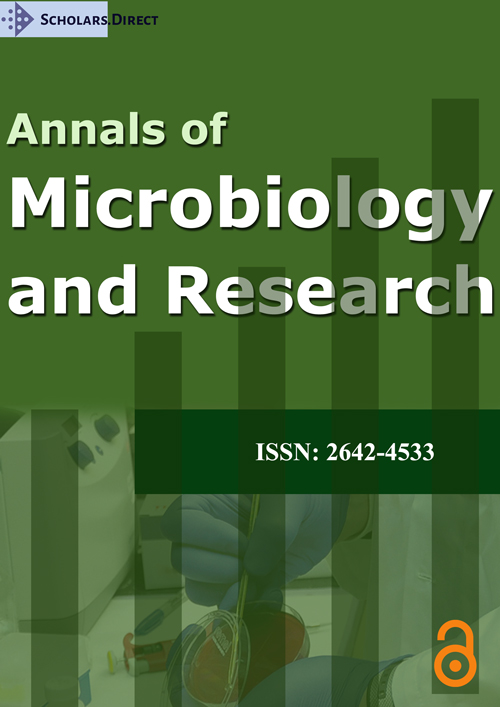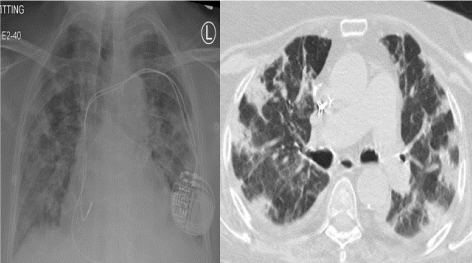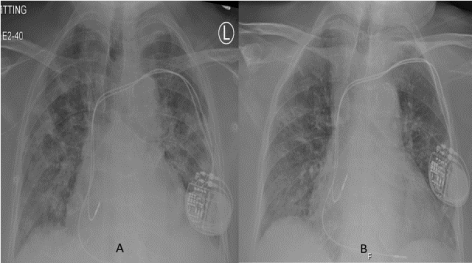Long Term Azithromycin use Reverses Post COVID-19 Lung Inflammation AND Fibrosis
Abstract
Corona Virus (COVID-19) disease has affected large number of people around the globe. Pandemic still not in control and it is still causing significant morbidity and mortality. One significant problem that is emerging post COVID-19 illness is the residual lung infiltrates/inflammation/fibrosis causing significant respiratory morbidity in these patients.
No effective treatment has been established to address this problem. Azithromycin has an anti-cytokine and anti-fibrotic effects which are well described in literature. Cytokine storm and associated lung inflammation is the leading cause for the lung damage and fibrosis in COVID-19 associated lung disease. The process potentially could be reversed by the long term use of Azithromycin in these patients.
We describe a case of an 86-year-old female who suffered a severe lung inflammation and post COVID recovery lung fibrosis. She was successfully treated with long term use of Azithromycin with almost complete radiological and clinical recovery of lung disease, she was weaned off from oxygen supplement and currently is with stable respiratory status maintains 96-98% saturation on room air. Without shortness of breath at rest or any significant respiratory complaints.
Case Report
86-years-old female known case of advanced preserved ejection fraction heart failure, atrial fibrillation S/P pacemaker placement, recurrent chest infection, recurrent urinary tract infection, and progressive dementia, was admitted with acute febrile illness and shortness of breath requiring oxygen supplement, initial physical examination revealed an elderly female, alert and responsive, in moderate respiratory distress, respiratory rate 22 per minute, maintaining oxygen saturation of 94-96% on 4L per minute nasal oxygen supplement. Beside bilateral scattered lung crepitation on auscultations, rest of physical exam was unremarkable. Initial work up revealed lung infiltrates on chest x ray (CXR) and computer tomography of the chest (CT chest), rapidly rising inflammatory markers C-reactive protein (CRP), ESR, Ferritin and lactate dehydrogenase (LDH), respiratory secretions viral screen was positive for Coronavirus disease (COVID-19). Patient was given azithromycin and supportive care. Due to rapidly rising inflammatory markers and progressive lung infiltrates, patient was diagnosed to be in cytokine-inflammatory response syndrome (CIRS) a decision was made to give her a single dose (IL6 antibody) Tocilizumab.
On subsequent worsening of lung infiltrates on CXR and CT chest. Patient was given dexamethasone 6 mg daily for 6 days, due to persistent lymphopenia, instead of second dose of Tocilizumab, patient was given half the recommended dose of interferon-beta-1b (8 million units). The patient required non-invasive ventilation to support the respiratory status. Patient received empiric broad spectrum antibiotics and a short course of anti-fungal coverage due to increasing lung infiltrates and heavily immune suppressed status.
Patient clinical status stabilized with improvement in respiratory and overall clinical status, patient was weaned off from the non-invasive ventilation successfully. The inflammatory markers remained high and patient was left with extensive lung infiltrates/fibrosis (Figure 1).
Decision was made to start patient on prednisone 1 mg/kg for residual lung fibrosis but due to persistent lymphopenia and patient's past history of frequent spontaneous fractures the dose was reduced to 0.5mg/kg and azithromycin was added 250 mg/3 times/week for its anti-inflammatory and anti-fibrotic effect. Prednisone was rapidly tapered down to a maintenance of 7.5 mg daily dose in 4 weeks' time period. Azithromycin 250 mg 3times/week was continued. Patient's inflammatory markers CRP, Ferritin progressively declined and her lung infiltration and fibrosis significantly improved.
3-monthspost therapy the radiological assessment showed significant recovery with almost complete resolution of lung inflammation and fibrosis (Figure 2).
Patient was weaned off from oxygen supplement, currently maintains oxygen saturation between 96-98% on room air, with stable respiratory and clinical status.
Discussion
COVID-19 lung involvement with associated acute respiratory distress syndrome (ARDS) secondary to CIRS is the main cause of lung disease associated mortality and morbidity. Post recovery from COVID-19 infection the residual lung damage with predominant lung infiltrates and fibrosis is the main cause of post recovery morbidity [1-4].
No definite treatment strategy has been studied to address the residual lung damage and fibrosis after recovery from acute illness [5].
Azithromycin have been used as anti-fibrotic [6], anti-inflammatory and as immune modulator [7] in many conditions with positive therapeutic response due to its well established anti-cytokine and anti-fibrotic effect, studies have shown significant benefit in bronchiolitis obliterans (BO) [8,9], bronchiectasis [10], and emphysema/ chronic obstructive airway disease (COPD) [11].
This is the first case report of long term use of Azithromycin showing significant reversal of lung inflammation and fibrosis in post COVID-19 lung involvement. Post recovery from COVID-19 infection, our patient was left with significant lung disease requiring high nasal oxygen supplementation to maintain adequate oxygen saturation and stable respiratory status.
Due to known steroid side effects in our patient with osteoporosis and significant history of recurrent urinary tract infection and spontaneous fractures patient was initially started on high dose of prednisone 1 mg/kg after completion of 6 days of Dexamethasone 6 mg daily dose, which was tapered down rapidly to 7.5 mg daily in 4 weeks' time period. As steroids were being tapered down.
Azithromycin 250 mg was added as anti-inflammatory and anti-fibrotic therapy. Patient started to show resolution in lung infiltrates with significant recovery from lung inflammation and fibrosis. Patient was completely weaned off from the oxygen supplement and currently maintains a room air Oxygen saturation of 97-98%.
Follow up CXR shows almost complete resolution of the lung disease. Due to significant clinical and radiological improvement on chest xray, a follow up CT chest to confirm CXR finding was not considered necessary.
Since large number of patients suffer from lung inflammation and fibrosis post COVID-19 disease many are left with significant respiratory morbidity. There are no established available treatments currently to address the problem of post COVID-19 lung inflammation and fibrosis, our cases signify a potential benefit of using long term (3 month) Azithromycin with successful resolution of residual lung infiltrates and fibrosis.
Conclusion
We believe that long term use of azithromycin may be of good value and a possible successful treatment for post COVID-19 lung inflammation and fibrosis. Larger studies need to be conducted to substantiate our findings.
References
- Zhang P, Li J, Liu H, et al. (2020) Long-term bone and lung consequences associated with hospital-acquired severe acute respiratory syndrome: A 15-year follow-up from a prospective cohort study. Bone Res 8:8.
- Das KM, Lee EY, Singh R, et al. (2017) Follow-up chest radiographic findings in patients with MERS-CoV after recovery. Indian J Radiol Imaging 27: 342-349.
- Brown KK, Martinez FJ, Walsh SLF, et al. (2020) The natural history of progressive fibrosing interstitial lung diseases. Eur Respir J 55: 2000085.
- Spagnolo P, Balestro E, Aliberti S, et al. Pulmonary fibrosis secondary to COVID-19: A call to arms? Lancet Respir Med 8: 750-752.
- Lechowicz K, Drozdzal S, Machaj F, et al. (2020) COVID-19: The potential treatment of pulmonary fibrosis associated with SARS-CoV-2 Infection. J Clin Med 9: 1917.
- Alam M, Bastakoti B (2015) Therapeutic Guidelines: Antibiotic. Version 15. AustPrescr 38:137.
- Parnham MJ, Erakovic Haber V, Giamarellos-Bourboulis EJ, et al. (2014) Azithromycin: Mechanisms of action and their relevance for clinical applications. Pharmacol Ther 143: 225-245.
- Khalid M, Al Saghir A, Saleemi S, et al. (2005) Azithromycin in bronchiolitis obliterans complicating bone marrow transplantation: A preliminary study. Eur Respir J 25: 490-493.
- Safavi S, Prayle AP, Hall IP, et al. (2017) Azithromycin for treatment of bronchiolitis obliterans syndrome in adult lung transplant recipients. Cochrane Database Syst Rev 2017: 012782.
- Valery PC, Morris PS, Byrnes CA, et al. (2015) Long-term azithromycin for Indigenous children with non-cystic-fibrosis bronchiectasis or chronic suppurative lung disease (Bronchiectasis Intervention Study): A multicentre, double-blind, randomised controlled trial. Lancet Respir Med 1: 610-620.
- Albert RK, Connett J, Bailey WC, et al. (2011) Azithromycin for prevention of exacerbations of COPD. N Engl J Med 365: 689-698.
Corresponding Author
Mohammed Khalid, MD, Section of Pulmonary Medicine, Department of Medicine, MBC46, King Faisal Specialist Hospital and Research Center, P O Box 3354, Riyadh 11211, Saudi Arabia, Tel: 966-504181890
Copyright
© 2021 Khalid M. This is an open-access article distributed under the terms of the Creative Commons Attribution License, which permits unrestricted use, distribution, and reproduction in any medium, provided the original author and source are credited.






